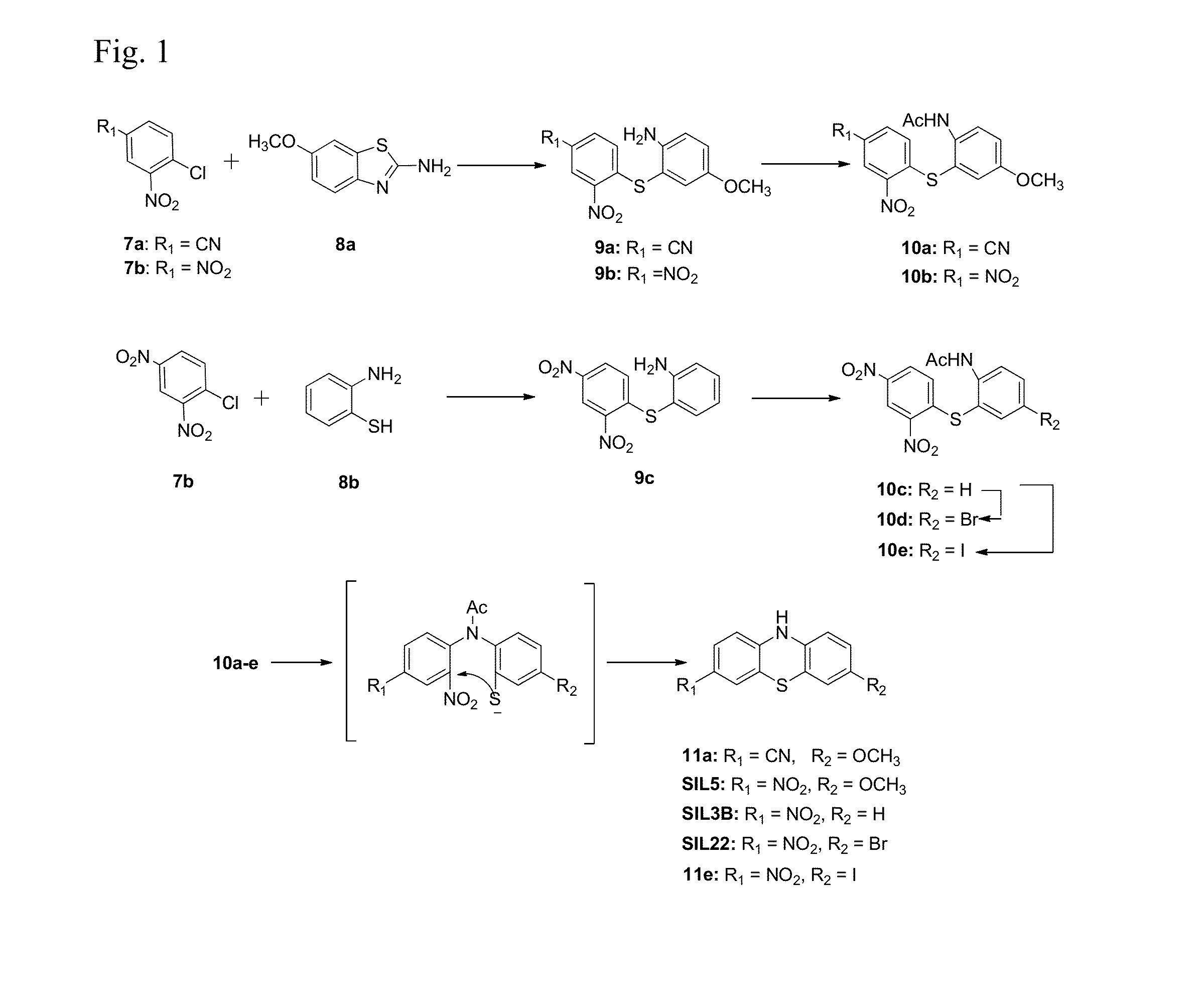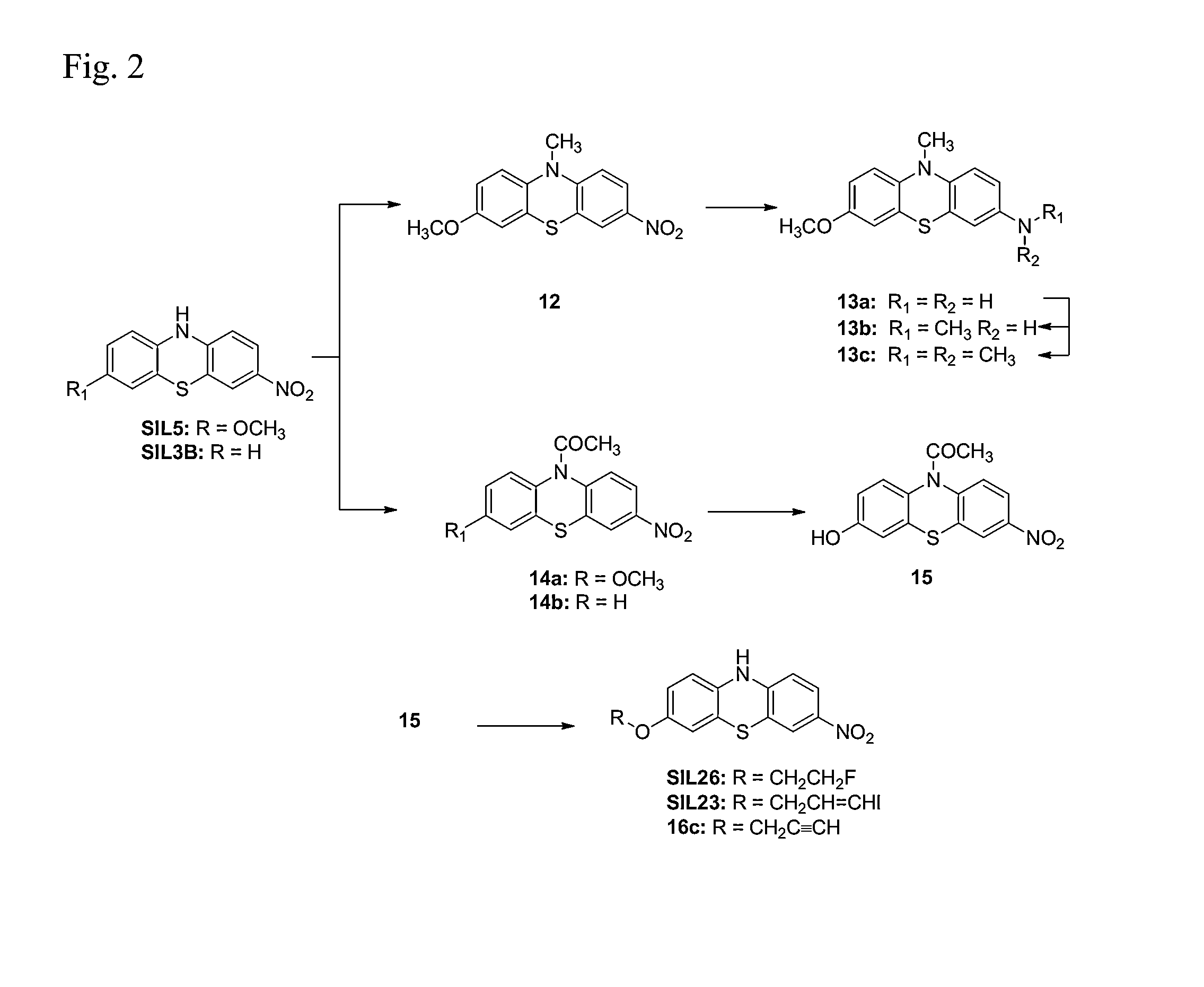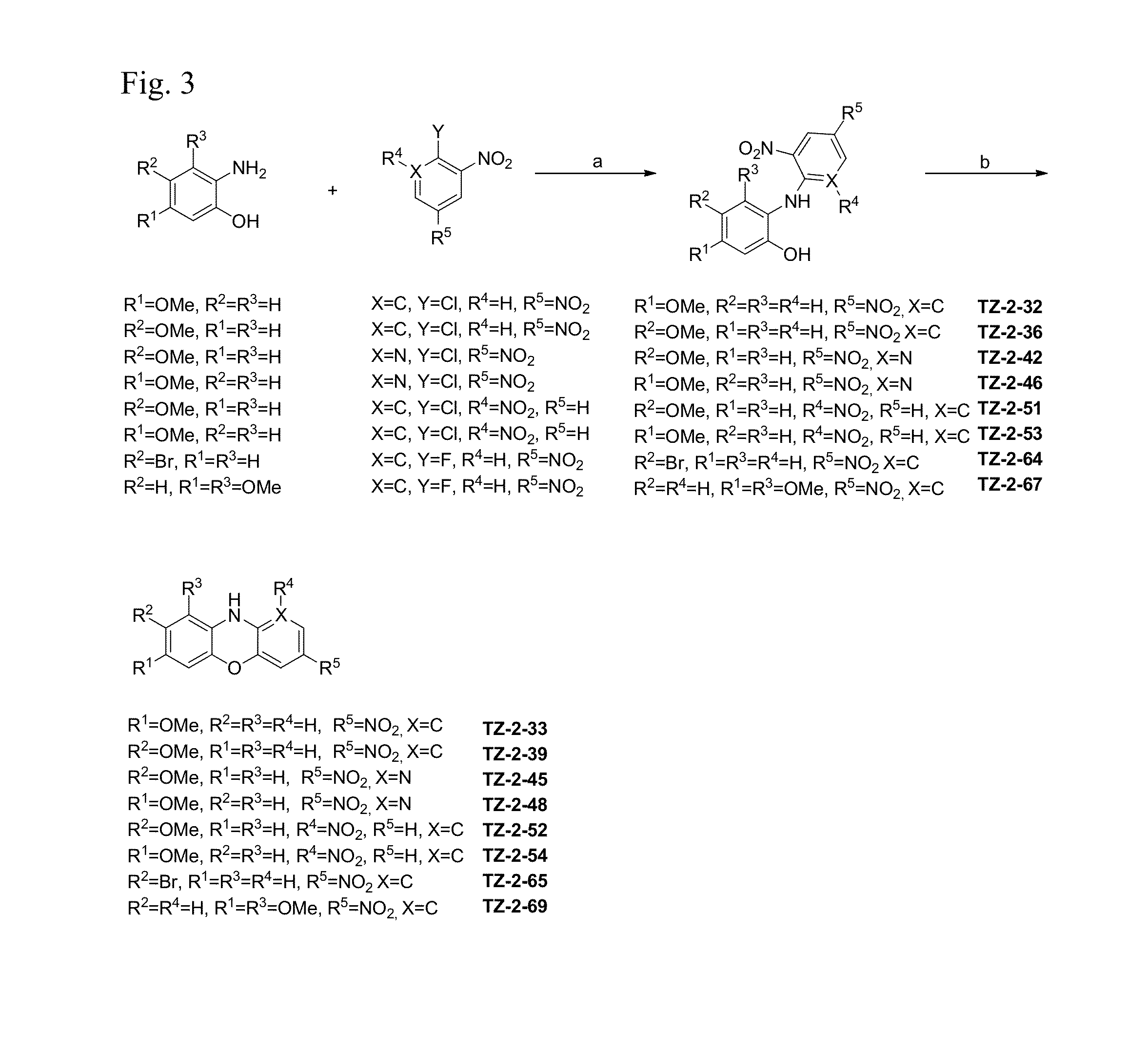Tricyclic heteroaromatic compounds as alpha-synuclein ligands
a technology of alpha-synuclein and heteroaromatic compounds, which is applied in the field of derivatives of phenothiazine, phenoxazine, and phenazine compounds, and can solve the problems of underlying aggregates that are detrimental, specific proteins no longer functional, and cell viability threats
- Summary
- Abstract
- Description
- Claims
- Application Information
AI Technical Summary
Benefits of technology
Problems solved by technology
Method used
Image
Examples
example 1
Synthesis of 3,7-dimethoxy-10H-phenothiazine (Compound 6)
[0122]3,7-dimethoxy-10H-phenothiazine was prepared according to the following reaction scheme:
[0123]4-Aminoanisole (0.3 g, 2.5 mmol; Compound 4), 4-bromoanisole (0.36 g, 2 mmol), CuI (75 mg, 0.4 mmol), L-proline (95 mg, 0.8 mmol) and K2CO3 (1.1 g, 8 mmol) were mixed in 10 ml of dimethyl sulfoxide (DMSO) and heated at 100° C. for 2 days. The reaction mixture was quenched with water (50 mL) and extracted with ethyl acetate. The organic phase was dried over anhydrous Na2SO4 and concentrated. The crude product was purified via column chromatography on silica gel to yield bis(4-methoxy)amine (Compound 5) as a white solid (0.15 g, 33%). 1H NMR (CDCl3): δ=3.76 (s, 6H), 5.29 (b, 1H), 6.81 (d, 4H, J=9.0 Hz), 6.93 (d, 4H, J=9.0 Hz); mp 92.4-95.0° C.
[0124]Compound 5 (0.15 g, 1.14 mmol), sulfur (91 mg, 2.3 mmol) and iodine (29 mg, 0.1 mmol) were added to 1,2-dichlorobenzene (10 mL). The reaction mixture was heated at 150° C. for 12 hours....
example 2
Synthesis of 7-methoxy-10H-phenothiazine-3-carbonitrile (Compound 11a)
[0125]Compound 11a was prepared according to the reaction scheme provided in FIG. 1.
[0126]6-Methoxybenzothiazol-2-amine (0.5 g, 2.8 mmol; Compound 8a) was suspended in aqueous potassium hydroxide solution and refluxed overnight. The reaction solution was cooled to room temperature and then added dropwise to a solution of 4-chloro-3-nitrobenzonitrile (0.51 g, 2.8 mmol; Compound 7a) in ethanol (20 mL) / acetic acid (50 mL) in a water bath. The reaction mixture was stirred for an additional 3 hours. The precipitate was filtered and washed with a 1:1 mixture of water:ethanol to give 4-((2-Amino-5-methoxyphenyl)thio)-3-nitrobenzonitrile (Compound 9a) as a red solid. (0.51 g, 60%). 1H NMR (CDCl3): δ=3.77 (s, 3H), 3.99 (b, 2H), 6.85 (d, 1H, J=8.4 Hz), 6.98 (m, 3H), 7.58 (d, 1H, J=8.7 Hz), 8.56 (s, 1H); mp 163.6-165.1° C.
[0127]Acetic anhydride (10 mL) and pyridine (2 mL) was added to a flask containing Compound 9a (0.3 g, 0...
example 3
Synthesis of 3-methoxy-7-nitro-10H-phenothiazine (Compound SIL5)
[0129]Compound SIL5 was prepared according to the reaction scheme provided in FIG. 1.
[0130]Compound 8a (5 g, 28 mmol) was suspended in aqueous potassium hydroxide solution and refluxed overnight. The reaction solution was cooled to room temperature and then added dropwise to a solution of 2,4-dinitrochlorobenzene (6.7 g, 28 mmol; Compound 7b) in ethanol (20 mL) / acetic acid (50 mL) in a water bath. The reaction mixture was stirred for an additional 3 hours. The precipitate was filtered and washed with a 1:1 mixture of water:ethanol to give 2-((2,4-dinitrophenyl)thio)-5-methoxyaniline (Compound 9b) as a yellow solid (7.3 g, 81%). 1H NMR (CDCl3): δ=3.76 (s, 3H), 4.00 (b, 2H), 6.85 (d, 1H, J=8.4 Hz), 6.96-7.06 (m, 3H), 8.18 (d, 1H, J=9.0 Hz), 9.13 (s, 1H); mp 169.4-171.7° C.
[0131]Acetic anhydride (10 mL) and pyridine (2 mL) was added to a flask containing Compound 9b (0.3 g, 0.93 mmol). The solution was stirred for 3 hours ...
PUM
| Property | Measurement | Unit |
|---|---|---|
| Pharmaceutically acceptable | aaaaa | aaaaa |
Abstract
Description
Claims
Application Information
 Login to View More
Login to View More - R&D
- Intellectual Property
- Life Sciences
- Materials
- Tech Scout
- Unparalleled Data Quality
- Higher Quality Content
- 60% Fewer Hallucinations
Browse by: Latest US Patents, China's latest patents, Technical Efficacy Thesaurus, Application Domain, Technology Topic, Popular Technical Reports.
© 2025 PatSnap. All rights reserved.Legal|Privacy policy|Modern Slavery Act Transparency Statement|Sitemap|About US| Contact US: help@patsnap.com



